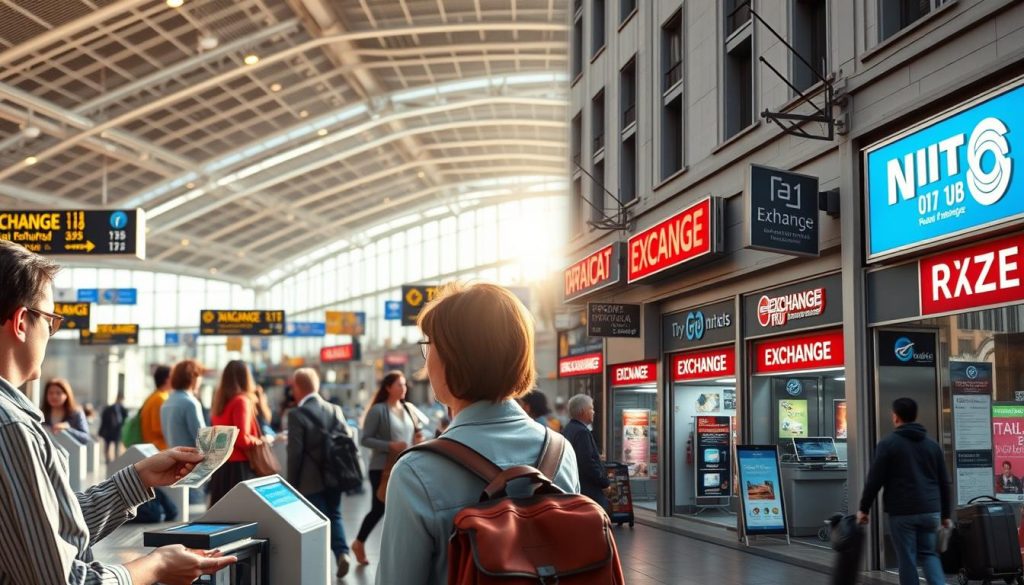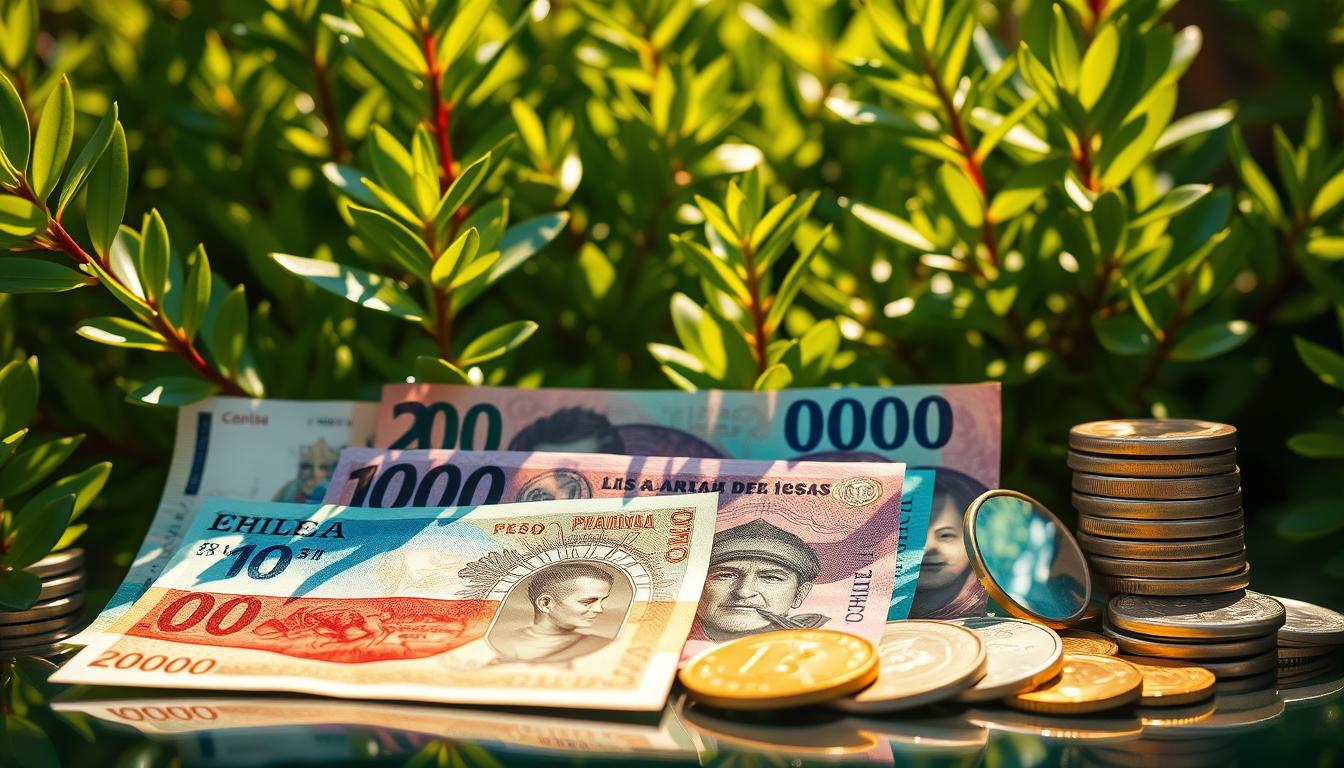✓ Accommodations✓ Flights✓ Rental Cars✓ Tours & Activities
Did you know that the exchange rate for the Chilean Peso (CLP) can fluctuate by up to 10% in a single week? This makes planning your finances essential for a smooth trip. The official currency chile uses is the CLP, and understanding how it works can save you time and money.
Whether you’re shopping at local markets or dining at a restaurant, knowing the exchange rate dynamics is crucial. This guide will help you navigate the chilean peso system, from cash to card payments, ensuring you’re prepared for every transaction.
You’ll also learn practical tips on where to get the best rates and how to avoid unnecessary fees. Let’s dive into everything you need to know about managing your money efficiently during your visit.
Overview of Chilean Currency and Payment Options
The Chilean Peso plays a central role in everyday transactions across the country. As the official currency, it’s essential to understand its value and how it works. The Peso is subdivided into 100 centavos, and you’ll find coins and banknotes in various denominations.
Exchange rates for the Peso are determined by market forces, with occasional government intervention. This means the rate can fluctuate, so staying updated with live data is crucial. Monitoring these changes helps you control costs and make informed decisions.
The Role of the Chilean Peso (CLP)
The Peso has been the primary currency since its introduction in 1975. It’s widely accepted in cities like Santiago and smaller towns alike. While cash is common, especially in rural areas, card payments are increasingly popular in urban centers.
Popular Payment Methods for Travelers
Travelers have several options for managing their money. Debit cards, like the Wise card, are convenient for easy transactions. ATMs are widely available, but be aware of withdrawal fees, which can vary by bank.
Cash remains a reliable choice, particularly for small purchases. However, carrying large amounts isn’t recommended. Card payments are accepted in most establishments, though some may charge a small fee. Staying informed about currency exchange options ensures you get the best value for your money.
Chile: Ultimate Travelers Guide to Currencies & Payments
Navigating foreign transactions doesn’t have to be complicated. With the right tools and knowledge, you can manage your money efficiently. Whether you’re using a card or carrying cash, understanding the local payment system is crucial.

Cards are widely accepted in urban areas, making them a convenient option. However, always ensure you’re charged in the local Chilean Peso (CLP) to avoid dynamic currency conversion fees. This simple step can save you money on every transaction.
While cards are handy, carrying some cash is still essential. In rural areas, card acceptance may be limited, and small vendors often prefer cash. Having a mix of both ensures you’re prepared for any situation.
Understanding the nuances of the Chilean Peso is also vital. Exchange rates can fluctuate, so staying informed helps you make smarter financial decisions. By combining the right payment methods and staying aware of local practices, you can avoid unnecessary fees and enjoy a seamless experience.
Ready to dive deeper? The next sections will provide detailed strategies and practical tips to optimize your financial planning during your trip.
Getting the Best Exchange Rates for Chile
Understanding exchange rates can make a big difference in how much you spend during your trip. The official currency in the country is the Chilean Peso (CLP), and knowing how to get the best rates ensures you maximize your money.
Mid-Market Rate vs. Retail Exchange Rates
The mid-market rate is the real exchange rate between two currencies, determined by global markets. It’s the rate banks use when trading with each other. Retail exchange providers, however, often add a markup, which means you get less for your money.
Using the mid-market rate is ideal because it’s fair and transparent. Retail providers, like those at airports or hotels, typically offer worse rates. Always compare rates online before exchanging cash to ensure you’re getting the best deal.
How to Monitor Live Exchange Rates
Staying updated with live exchange rates is crucial for timing your conversions. Websites and apps like XE or Wise provide real-time data, helping you decide when to exchange your money.
Monitoring rates also helps you avoid unnecessary fees. For example, some ATM withdrawals include hidden charges. By planning ahead, you can minimize these costs and keep more of your budget for experiences.
Here’s a quick comparison of mid-market and retail rates:
| Rate Type | Advantages | Disadvantages |
|---|---|---|
| Mid-Market Rate | Fair, transparent, no markup | Not always available at retail providers |
| Retail Rate | Convenient, widely available | Includes markup, less value for your money |
By focusing on the mid-market rate and avoiding high fees, you can make smarter financial decisions. Whether you’re using a debit card or exchanging cash, staying informed ensures you get the most out of your trip.
How to Exchange Money Before and During Your Chilean Trip
Planning your finances before your trip can save you time and money. Whether you exchange your currency before departure or after arrival, understanding your options ensures you get the best value for your peso.

Exchanging Currency Before Departure
Exchanging your money before you leave can be a smart move. Many banks and trusted providers offer competitive rates, which can save you from unfavorable exchange conditions later. This approach also lets you start your trip with local currency in hand, avoiding delays upon arrival.
Smaller denominations of banknotes are particularly useful for local purchases. Having 1,000 or 2,000 peso notes ensures you’re prepared for taxis, snacks, or tips without needing change.
On-Arrival Exchange Options
If you prefer to exchange money after arriving, city centers are your best bet. Currency exchange bureaus here often offer better rates than airports. However, always compare rates to avoid hidden fees.
Airport exchanges are convenient but usually come with higher rates. If you need cash immediately, exchange only a small amount and wait to find a better deal in the city.
| Option | Advantages | Disadvantages |
|---|---|---|
| Pre-Trip Exchange | Better rates, no delays, smaller denominations | Requires planning, limited availability |
| On-Arrival Exchange | Convenient, widely available | Higher rates, potential fees |
By comparing these options, you can decide what works best for your travel plans. Whether you exchange before or after, staying informed ensures you get the most out of your peso.
Payment Methods in Chile: Cash, Card, and Alternatives
Managing your money efficiently is key to a stress-free trip. Understanding the available payment options ensures smooth transactions and helps you avoid unnecessary fees. Whether you prefer cards, cash, or digital wallets, knowing what works best for your needs is essential.
Advantages of Using Debit and Credit Cards
Cards are a popular choice for travelers due to their convenience and security. Debit cards allow you to spend money you already have, avoiding interest charges. Credit cards offer additional benefits like rewards programs and fraud protection.
Travel-specific cards, such as Wise or Revolut, are particularly useful. They often feature lower foreign transaction fees and real-time conversion rates. This makes them ideal for managing your account while abroad.
Using cards also reduces the need to carry large amounts of cash. Most urban establishments accept cards, making them a reliable option for everyday purchases.
Pros and Cons of Carrying Cash
Cash remains a practical choice, especially in rural areas or for small purchases. Local markets, taxis, and small vendors often prefer cash over cards. Carrying smaller denominations, like 1,000 or 2,000 coin notes, ensures you’re prepared for any situation.
However, carrying large amounts of cash is not recommended due to security concerns. It’s also less convenient for larger transactions, as you’ll need to manage change and storage.
Here’s a quick comparison of cards and cash:
| Method | Advantages | Disadvantages |
|---|---|---|
| Cards | Secure, convenient, rewards | May incur fees, not accepted everywhere |
| Cash | Widely accepted, no fees | Security risks, less convenient for large purchases |
By combining cards and cash, you can enjoy the benefits of both. This flexible approach ensures you’re prepared for any transaction during your trip.
Tips for Using ATMs and Debit Cards in Chile
Using ATMs in Chile can be a smart way to access local currency efficiently. They often provide a good exchange rate, making them a preferred option for travelers. However, knowing how to use them safely and cost-effectively is key to maximizing your funds.

Best Practices for ATM Withdrawals
When withdrawing cash, always verify that you’re charged in the local currency (CLP) to avoid dynamic currency conversion fees. This ensures you get the best price for your dollar. Many ATMs offer English options, but it’s helpful to know basic Spanish phrases for smoother transactions.
Plan your withdrawals to avoid running out of cash unexpectedly. ATMs in Chile have a maximum limit of $200,000 CLP per transaction, so you may need to withdraw multiple times. Keep in mind that fees can range from $4,000 to $7,000 CLP, depending on the provider.
Here’s a quick comparison of ATM providers:
| Provider | Fees | Advantages |
|---|---|---|
| Bank-Owned ATMs | Up to $4,000 CLP | Reliable, lower fees |
| Independent ATMs | Up to $7,000 CLP | Widely available |
To ensure a good exchange rate, compare the withdrawal price with live exchange rate data. This helps you avoid unnecessary costs and get the most value for your dollar.
Researching different ATM providers is another smart option. Bank-owned ATMs often have lower fees, while independent ones may be more convenient. By choosing the best option for your needs, you can save money and time during your trip.
Managing Currency Conversion Fees and Transaction Costs
Currency conversion fees can sneak up on you if you’re not careful. Whether you’re withdrawing cash or making a card payment, understanding these costs ensures you don’t overspend. This section breaks down the key fees to watch for and how to avoid them.
Understanding Foreign Transaction Fees
Foreign transaction fees are charges added when you use your credit or debit card abroad. These fees typically range from 1% to 3% of the transaction amount. For example, if you spend $100, you could pay an extra $3 in fees.
Some banks and travel cards, like Wise or Revolut, offer fee-free international transactions. Always check your card’s terms before traveling to avoid surprises.
Dynamic Currency Conversion Pitfalls
Dynamic currency conversion (DCC) occurs when a merchant offers to charge you in your home currency instead of the local one. While it sounds convenient, it often comes with poor exchange rates and hidden fees.
“Always choose to pay in the local currency to avoid DCC markups.”
This is especially common at airport kiosks and hotels. Opting for the local currency ensures you get a fairer rate.
Saving Money on Currency Conversion
Here are actionable tips to minimize costs:
- Use a travel-friendly credit card with low or no foreign transaction fees.
- Avoid exchanging money at airports, where rates are less favorable.
- Compare exchange rates in the city to find the best deal.
- Withdraw larger amounts at ATMs to reduce per-transaction fees.
Here’s a comparison of common fee structures:
| Provider | Foreign Transaction Fee | Exchange Rate Markup |
|---|---|---|
| Standard Credit Card | 2-3% | High |
| Travel Card (e.g., Wise) | 0% | Low |
| Airport Exchange | 5-15% | Very High |
By following these tips, you can save significantly on currency conversion and enjoy more of your travel budget.
Navigating Currency Exchange in Airports vs City Centers
When it comes to exchanging money, location matters more than you might think. Where you choose to exchange money can significantly impact the rates you get and the fees you pay. Airports and city centers are the two most common options, but they differ greatly in terms of convenience and cost.

Airports are convenient, especially if you need cash immediately after landing. However, they often charge higher fees and offer less favorable rates. This is because they operate in a captive market, where travelers have limited options.
On the other hand, city centers typically provide better rates. Local exchange bureaus and banks compete for business, which often results in more competitive pricing. Planning ahead and researching options in the city can help you secure a good exchange rate.
Comparing Rates at Airports and Downtown Locations
Airport exchanges are known for their markups, which can range from 5% to 15% above the mid-market rate. While this might not seem like much, it adds up quickly, especially for larger transactions. If you must exchange money at the airport, limit the amount to what you need for immediate expenses.
City centers, however, offer a wider range of options. Banks and independent exchange bureaus often provide better rates and lower fees. It’s worth taking the time to compare rates at a few locations to ensure you’re getting the best deal.
Here’s a quick comparison of the two options:
| Location | Advantages | Disadvantages |
|---|---|---|
| Airport | Convenient, available 24/7 | Higher fees, less favorable rates |
| City Center | Better rates, lower fees | Requires research, may involve travel |
Carrying cash is essential for minor transactions, especially in areas where card payments are less common. Smaller denomination notes, like 1,000 or 2,000 pesos, are particularly useful for taxis, tips, and small purchases. They also make it easier to receive change without hassle.
Planning ahead is key to managing your money effectively. Researching local exchange stores and monitoring live rates can help you secure a good exchange. By choosing the right location and being prepared, you can save money and enjoy a smoother travel experience.
Managing Your Money: Banking and Multi-Currency Cards
Managing your finances while traveling can be simpler with the right tools. Multi-currency accounts and travel debit cards are designed to make international transactions seamless. These tools help you avoid unnecessary fees and keep your spending organized.
Setting Up a Multi-Currency Account
Opening a multi-currency account before your trip can save you time and money. Services like Wise allow you to hold and convert funds in multiple currencies at competitive rates. This means you can pay in the local currency without worrying about high conversion fees.
These accounts are especially useful for frequent travelers or those visiting multiple countries. You can manage your funds online, making it easy to track your spending. Plus, you’ll get access to live rates from the central bank, ensuring you always get the best deal.
Using a Travel Debit Card Effectively
Travel debit cards are a convenient way to access your money abroad. They often come with low or no foreign transaction fees, making them ideal for tourist spending. Cards like Wise or Revolut also offer real-time conversion rates, so you know exactly how much you’re spending.
When using your card, always choose to pay in the local currency to avoid dynamic currency conversion fees. This is especially important at hotels or local stores, where DCC can add unnecessary costs. Withdrawing cash from ATMs is also straightforward, but be mindful of withdrawal limits and fees.
Here are some tips to maximize your travel debit card experience:
- Monitor live exchange rates to time your transactions wisely.
- Use your card for larger purchases to minimize fees.
- Keep a small amount of cash for places that don’t accept cards.
By combining a multi-currency account with a travel debit card, you can streamline your finances and focus on enjoying your trip. These tools not only save you money but also provide peace of mind while traveling.
Conclusion
To make the most of your financial planning, focus on smart strategies that save you money and time. Understanding the mid-market exchange rate is crucial for getting the best value. A multi-currency card simplifies transactions and helps you avoid unnecessary fees.
Here’s a quick recap: track the mid-market exchange rate, avoid dynamic conversions, and plan your cash needs wisely. Using a multi-currency card ensures seamless transactions and better exchange deals.
Apply these tips when setting up your banking and card services before and during your trip. With the right tools and knowledge, you can enjoy your travel experience with confidence in your financial strategies.
The above is subject to change.
Check back often to TRAVEL.COM for the latest travel tips and deals.






